Kumari – the living goddesses of Nepal#
byPreviously a kingdom with long traditions, the Himalayan country Nepal Nepal, India , has been a Republic since 2008. Nepal has an area of 147 181 square kilometers and 31 million inhabitants. About 75 ethnic groups live in the mountain areas as well as in the wide river basins and valleys bordering India. These ethnic groups can be linguistically counted as members of the Tibeto-Burmese tribes.
The Newar population in the basin of Kathmandu is the culturally most influential one. Until the takeover by the North Indian Gorkha dynasty in 1768 there were three small kingdoms in the Kathmandu Valley: Kathmandu Kathmandu, Nepal , Lalitpur / Patan Patan, Nepal and Bhaktapur / Bhadgaon Nepal, Bhaktapur . Due to the outstanding architectural and artistic achievements of the Newar people all three cities belong to the World Cultural Heritage.
The two world religions Hinduism and Buddhism are predominent in Nepal. Buddhism in two variations, Mahayana and Vajrayana, the latter much based on the strong Tibetan groups with their growing number of monasteries and other cultic sites. The Buddhist influence is older than the Hindu one. In the Middle Ages the Hindu religion developed the ideas of the Indian caste system, its cults and its pantheon. Around 80% of the population are Hindus. Hindu religion contains elements from the pre-Buddhist and pre-Hinduist cults and deities.
One of the unique specialities is that in some cities of the Kathmandu valley the worship of childlike “living goddesses” is being practised. Such girls are called Kumari. Kumari is the female form of the old Indian Sanskrit word Kumara, meaning “Prince, young man”. In southern India the god of war. Karttikeya, son of the divine couple Shiva and Parvati, is also called Kumara and is still worshiped. In Nepal, a Kumari is a virgin girl whorshiped as a goddess for a until she reaches puberty.
As deified person a Kumari is – during the period of her potency - considered to be the personification of Goddess Taleju, who in turn goes back to the pre-Hindu roots. In Hinduism she is interpreted as one of the wives of Shiva, the amazonian-like Durga.
The cult around these divine females is mainly influenced by Hinduism. However, the girls are selected from a respected Buddhist goldsmith family, considering 32 different external and mental signs (Sanskrit lakshana) as well as the horoscope of birth. In most cases this is done already at the age of 3 to 4 years.
A Kumari girl wears a red robe and precious jewelry. She wears specific makeup on her forehead and around the eyes and sits on a throne. Her feet must not touch the ground and therefore rest on an ornate brass plate. She does not walk but is carreid around in the house. She is allowed to communicate verbally only with her family.
There have been Kumaris in Kathmandu, Patan, Bhaktapur und Bungamati since the 16th century. The Kumari in Kathmandu has also held an important political function. She blessed and thus confirmed the new king, who had just ascended the throne. Even after the end of the monarchy, the new communist Prime Minister asked for her “ blessing“. She lives in a beautiful building in the old city of Kathmandu near the King‘s palace. She appears rarely in public. If she appears, visitors see her only for a few seconds in a window of her house. Only on rare occassions like processions or temple festivals, she is carried in a litter in the midst of a crowd of people. At the festival of Indra Jatra she is driven through the city in a cultic carriage.
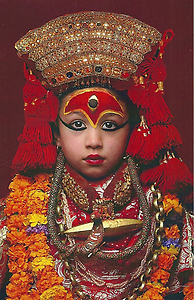
Foto: G. Jontes, under CC BY 4.0
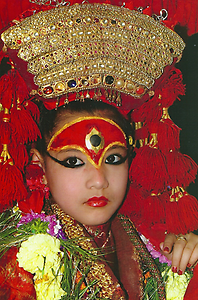
Foto: G. Jontes, under CC BY 4.0
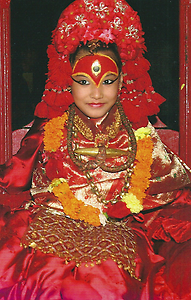
Foto: G. Jontes, under CC BY 4.0
The house of the Kumari is a brick building with magnificent carved portals and window frames. The roof is crowned by three jars of the potion of immortality (Sanskrit kalasha). The annex on the right side houses the disassembled float used for prosessions. The courtyard is also decorated elaborately.
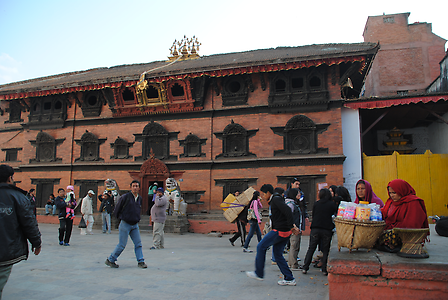
Foto: G. Jontes, under CC BY 4.0

Foto: G. Jontes, under CC BY 4.0
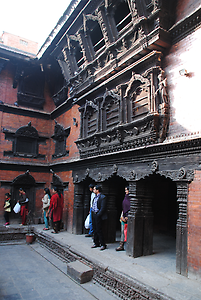
Foto: G. Jontes, under CC BY 4.0
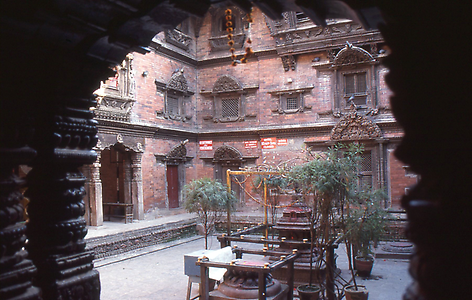
Foto: G. Jontes, under CC BY 4.0

Foto: G. Jontes, under CC BY 4.0

Foto: G. Jontes, under CC BY 4.0
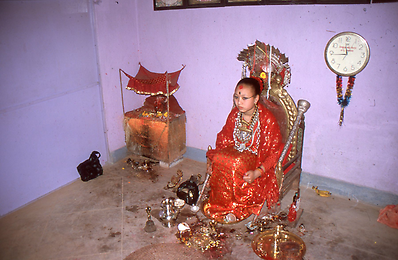
Foto: G. Jontes, under CC BY 4.0

Foto: G. Jontes, under CC BY 4.0

Foto: G. Jontes, under CC BY 4.0
When the period of divinity is over with the first menstruation, little remains of the former lifestyle. The government pays Kumaris a tiny pension. During that time her family, being always around her, has to take care that her bags are filled with donations of believers and visitors. In the past, the King invited former Kumaris to dinner once every year. An old superstition even prevents them from enjoying marital happiness, because it is said that a man who marries a Kumari will die within a year.
In Patan, there was a Kumari who was in office from the age of two, from 1953 to 1985. Her name is Dharma Dhana Bajracharya, and mentally she has never left her role. She continued living in the same house as her successors and received pilgrims and visitors until a few years ago.
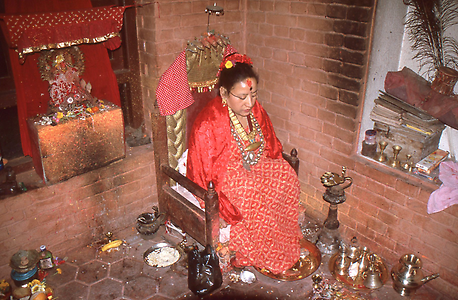
Foto: G. Jontes, under CC BY 4.0
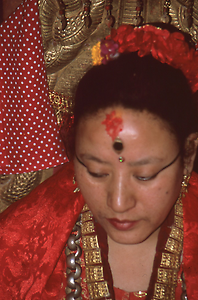
Foto: G. Jontes, under CC BY 4.0